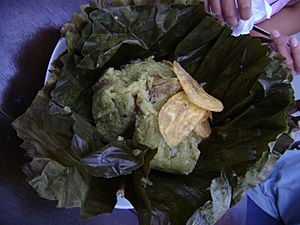Juane facts for kids

An unwrapped juane with chicken.
|
|
| Place of origin | Peru |
|---|---|
| Main ingredients | rice, meat, olives, hard-boiled egg, spices among others, bijao (macaw-flower) leaves |
The juane is a very popular dish from the Peruvian jungle. It's a special meal that many people enjoy on June 24th. This date is the feast of St. John the Baptist, also known as San Juan. That's why the dish is called "juane."
When Spanish people arrived in Peru a long time ago, they shared stories from the Bible. One well-known story was about the beheading of St. John. Some people believe the name "juane" might even be a reference to St. John's head.
Historically, juane was a great food for travelers. It could be stored for a long time without going bad. This made it a perfect meal to take on long journeys.
How to Make Juane
Making juane usually starts with rice. Other ingredients include meat, olives, and hard-boiled eggs. Many different spices are also added to give it flavor.
All these ingredients are mixed together. Then, the mixture is wrapped carefully in large bijao leaves. These leaves come from a plant called macaw-flower or heliconia. After wrapping, the juane is boiled for about an hour and a half.
Sometimes, instead of rice, people use other ingredients. These can include cassava, a plant called chonta, or even a mix of rice and cassava. Beans can also be used. Before wrapping, the mixture is often coated with beaten eggs. This helps the ingredients stick together so the juane doesn't fall apart.
People in different parts of the jungle enjoy juane with different side dishes. Some like to eat it with tacacho, which is mashed plantain. Others prefer it with cassava or simply boiled bananas.
Different Kinds of Juane
There are several delicious types of juane, each with its own special twist:
- Traditional juane: This is the classic version of the dish.
- Special juane: This type often includes extra ingredients or a unique preparation.
- Chonta juane: For this version, shredded chonta is mixed in with the rice.
- Cassava juane: Instead of rice, this juane uses ground cassava. It's usually filled with fish, especially paiche.
- Avispa juane: This type adds ground pork to the rice mixture. It's often filled with fried chicken.
- Nina juane: This juane is different because it uses pieces of chicken instead of rice.
- Sara juane: In this version, a mix of ground raw peanuts and ground corn is used instead of rice. It's also made with chicken broth.
See also
 In Spanish: Juane para niños
In Spanish: Juane para niños


